1-(4-Methylphenyl)cyclohexanecarbonitrile
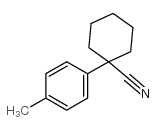
1-(4-Methylphenyl)cyclohexanecarbonitrile structure
|
Common Name | 1-(4-Methylphenyl)cyclohexanecarbonitrile | ||
|---|---|---|---|---|
| CAS Number | 1206-13-9 | Molecular Weight | 199.29100 | |
| Density | 1 | Boiling Point | 342.6ºC at 760 mmHg | |
| Molecular Formula | C14H17N | Melting Point | N/A | |
| MSDS | N/A | Flash Point | 128.1ºC | |
| Name | 1-(4-Methylphenyl)-1-cyclohexanecarbonitrile |
|---|---|
| Synonym | More Synonyms |
| Density | 1 |
|---|---|
| Boiling Point | 342.6ºC at 760 mmHg |
| Molecular Formula | C14H17N |
| Molecular Weight | 199.29100 |
| Flash Point | 128.1ºC |
| Exact Mass | 199.13600 |
| PSA | 23.79000 |
| LogP | 3.72048 |
| Vapour Pressure | 7.43E-05mmHg at 25°C |
| Index of Refraction | 1.5302-1.5322 |
Synonym:1-(4-Methylphenyl)cyclohexanecarbonitril Section 2 - COMPOSITION, INFORMATION ON INGREDIENTS
Risk Phrases: 20/21/22 Section 3 - HAZARDS IDENTIFICATION EMERGENCY OVERVIEW
Harmful by inhalation, in contact with skin and if swallowed.The toxicological properties of this material have not been fully investigated. Potential Health Effects Eye: May cause eye irritation. Skin: May cause skin irritation. Ingestion: May cause irritation of the digestive tract. The toxicological properties of this substance have not been fully investigated. Inhalation: May cause respiratory tract irritation. The toxicological properties of this substance have not been fully investigated. Chronic: No information found. Section 4 - FIRST AID MEASURES Eyes: Immediately flush eyes with plenty of water for at least 15 minutes, occasionally lifting the upper and lower eyelids. Get medical aid. Skin: Get medical aid. Flush skin with plenty of water for at least 15 minutes while removing contaminated clothing and shoes. Wash clothing before reuse. Ingestion: Never give anything by mouth to an unconscious person. Get medical aid. Do NOT induce vomiting. If conscious and alert, rinse mouth and drink 2-4 cupfuls of milk or water. Inhalation: Remove from exposure and move to fresh air immediately. If not breathing, give artificial respiration. If breathing is difficult, give oxygen. Get medical aid. Notes to Physician: Section 5 - FIRE FIGHTING MEASURES General Information: As in any fire, wear a self-contained breathing apparatus in pressure-demand, MSHA/NIOSH (approved or equivalent), and full protective gear. During a fire, irritating and highly toxic gases may be generated by thermal decomposition or combustion. Extinguishing Media: Use water spray, dry chemical, carbon dioxide, or appropriate foam. Section 6 - ACCIDENTAL RELEASE MEASURES General Information: Use proper personal protective equipment as indicated in Section 8. Spills/Leaks: Absorb spill with inert material (e.g. vermiculite, sand or earth), then place in suitable container. Provide ventilation. Section 7 - HANDLING and STORAGE Handling: Wash thoroughly after handling. Remove contaminated clothing and wash before reuse. Use with adequate ventilation. Avoid contact with eyes, skin, and clothing. Avoid ingestion and inhalation. Storage: Store in a tightly closed container. Store in a cool, dry, well-ventilated area away from incompatible substances. Section 8 - EXPOSURE CONTROLS, PERSONAL PROTECTION Engineering Controls: Facilities storing or utilizing this material should be equipped with an eyewash facility and a safety shower. Use adequate ventilation to keep airborne concentrations low. Exposure Limits CAS# 1206-13-9: Personal Protective Equipment Eyes: Wear appropriate protective eyeglasses or chemical safety goggles as described by OSHA's eye and face protection regulations in 29 CFR 1910.133 or European Standard EN166. Skin: Wear appropriate protective gloves to prevent skin exposure. Clothing: Wear appropriate protective clothing to prevent skin exposure. Respirators: A respiratory protection program that meets OSHA's 29 CFR 1910.134 and ANSI Z88.2 requirements or European Standard EN 149 must be followed whenever workplace conditions warrant respirator use. Section 9 - PHYSICAL AND CHEMICAL PROPERTIES Physical State: Clear liquid Color: clear, colorless Odor: None reported. pH: Not available. Vapor Pressure: Not available. Viscosity: Not available. Boiling Point: Not available. Freezing/Melting Point: Not available. Autoignition Temperature: Not applicable. Flash Point: Not applicable. Explosion Limits, lower: Not available. Explosion Limits, upper: Not available. Decomposition Temperature: Not available. Solubility in water: Not available. Specific Gravity/Density: 1.0060g/cm3 Molecular Formula: C14H17N Molecular Weight: 199.29 Section 10 - STABILITY AND REACTIVITY Chemical Stability: Stable under normal temperatures and pressures. Conditions to Avoid: Incompatible materials, strong oxidants. Incompatibilities with Other Materials: Oxidizing agents. Hazardous Decomposition Products: Irritating and toxic fumes and gases. Hazardous Polymerization: Has not been reported. Section 11 - TOXICOLOGICAL INFORMATION RTECS#: CAS# 1206-13-9 unlisted. LD50/LC50: Not available. Carcinogenicity: 1-(4-Methylphenyl)-1-cyclohexanecarbonitrile - Not listed by ACGIH, IARC, or NTP. Section 12 - ECOLOGICAL INFORMATION Section 13 - DISPOSAL CONSIDERATIONS Dispose of in a manner consistent with federal, state, and local regulations. Section 14 - TRANSPORT INFORMATION IATA Not regulated as a hazardous material. IMO Not regulated as a hazardous material. RID/ADR Not regulated as a hazardous material. Section 15 - REGULATORY INFORMATION European/International Regulations European Labeling in Accordance with EC Directives Hazard Symbols: XN Risk Phrases: R 20/21/22 Harmful by inhalation, in contact with skin and if swallowed. Safety Phrases: S 24/25 Avoid contact with skin and eyes. WGK (Water Danger/Protection) CAS# 1206-13-9: No information available. Canada None of the chemicals in this product are listed on the DSL/NDSL list. CAS# 1206-13-9 is not listed on Canada's Ingredient Disclosure List. US FEDERAL TSCA CAS# 1206-13-9 is not listed on the TSCA inventory. It is for research and development use only. SECTION 16 - ADDITIONAL INFORMATION N/A |
| Hazard Codes | Xn: Harmful; |
|---|---|
| Risk Phrases | R20/21/22;R36/37/38 |
| Safety Phrases | 36/37/39-26 |
|
~78% 
1-(4-Methylphen... CAS#:1206-13-9 |
| Literature: Yanagisawa, Arata; Nezu, Tetsuya; Mohri, Shin-Ichiro Organic Letters, 2009 , vol. 11, # 22 p. 5286 - 5289 |
|
~% 
1-(4-Methylphen... CAS#:1206-13-9 |
| Literature: US5274104 A1, ; US 5274104 A |
|
~% 
1-(4-Methylphen... CAS#:1206-13-9 |
| Literature: Journal of the American Chemical Society, , vol. 135, # 34 p. 12576 - 12579 |
| 1-(4-methylphenyl)cyclohexane-1-carbonitrile |
| 1-(P-TOLYL)-1-CYCLOHEXANECARBONITRILE |
| 1-(p-Tolyl)cyclohexanecarbonitrile |
| EINECS 214-888-4 |
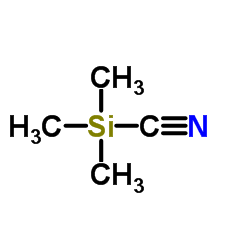
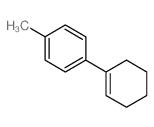

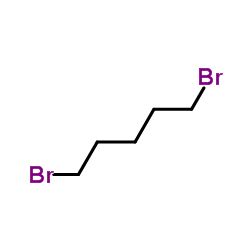
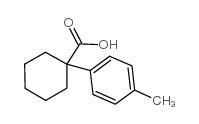 CAS#:84682-27-9
CAS#:84682-27-9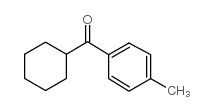 CAS#:2789-44-8
CAS#:2789-44-8